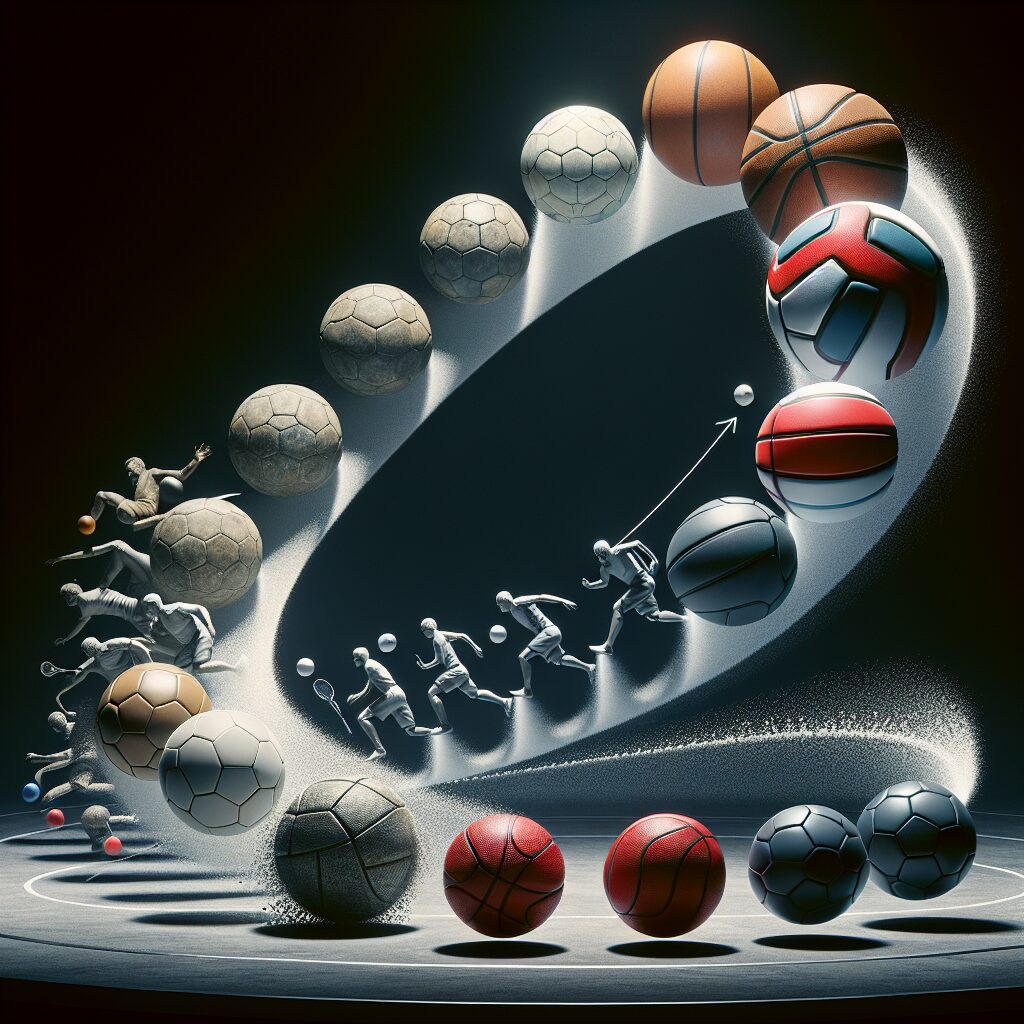Design’s Impact on Sport Performance: Ball Evolution
Throughout the history of sports, countless innovations have influenced the way athletes perform. One such innovation that has played a pivotal role in enhancing sport performance is the evolution of ball design. From the origins of sports to the present day, the design of sports balls has undergone significant transformations, resulting in improved performance and gameplay.
An interesting fact to note is that the design of sports balls has evolved in tandem with advancements in technology. In the early days, balls were made from materials such as leather, inflated animal bladders, or even stones. However, with the advent of modern manufacturing techniques and materials, balls have become more efficient, aerodynamic, and tailored to specific sports. This evolution in ball design has had a profound impact on sport performance, enabling athletes to achieve greater accuracy, speed, and control in their respective disciplines.
Looking ahead, this article will delve into the key takeaways of how ball design has influenced sport performance. We will explore the specific impacts of ball evolution on various sports, including soccer, basketball, tennis, and golf. Additionally, we will examine the unique features incorporated into the design of modern sports balls and how they contribute to enhancing athletes’ abilities. By understanding the intricate relationship between ball design and athletic performance, readers can gain valuable insights into the advances that have revolutionized the way sports are played.
Key Takeaways
1. Design plays a crucial role in sport performance, especially in the evolution of sporting balls.
2. Sports ball designs have continuously evolved over the years to enhance performance and address specific needs of different sports.
3. Innovations in ball design have focused on improving aerodynamics, trajectory, grip, and durability, resulting in better game performance and reduced injuries.
4. Material advancements have also contributed to improved ball performance, with synthetic materials offering benefits such as increased control and consistency.
5. The future of ball design is likely to involve further technological advancements, including smart balls and bio-inspired designs, shaping the future of sports performance.
How does the design of the ball evolve and impact sport performance?
The Role of Ball Design in Sport Performance
The design of sports balls plays a crucial role in determining the performance and overall outcome of a game. Whether it’s a soccer ball, basketball, tennis ball, or any other type of sports ball, the design elements can greatly impact the way the ball moves, bounces, and interacts with the athletes and the playing surface.
The Evolution of Ball Design
Over the years, the design of sports balls has undergone significant changes and improvements. Manufacturers constantly strive to enhance the performance, durability, and overall player experience by refining the design elements. The evolution of ball design can be seen in various aspects, including material selection, aerodynamics, grip, and overall construction.
Impact of Ball Design on Performance
The design of a sports ball directly affects the performance of athletes. Here are some key aspects of ball design that have a notable impact on sport performance:
1. Aerodynamics: The shape and surface of the ball can greatly influence its trajectory and flight path. A well-designed ball with proper aerodynamics allows athletes to make precise shots, passes, and throws with optimal control and accuracy.
2. Material Selection: The choice of materials used in the construction of a ball affects its weight, grip, and overall feel. Different sports require specific characteristics, such as bounce or spin, which can be achieved through material selection. For example, in tennis, the evolution from wooden to rubberized balls significantly improved player performance.
3. Grip and Texture: The surface texture of a ball can impact how it interacts with athletes’ hands or equipment. A ball with the right grip ensures better control, reduces slippage, and allows athletes to manipulate the ball more effectively.
4. Bounce and Rebound: The design of a ball determines its bounce and rebound properties. For instance, in sports like basketball, a ball with good bounce characteristics enables players to perform various maneuvers like dribbling and shooting accurately.
5. Durability and Consistency: The design aspects also affect the durability and consistency of a ball, which are crucial for fair gameplay. A well-designed ball maintains its shape, withstands regular impact, and provides a consistent performance throughout the game.
Conclusion
In conclusion, the design of sports balls has a significant impact on sport performance. The evolution of ball design has led to improved aerodynamics, material selection, grip, bounce, and durability, enhancing athletes’ abilities and overall gameplay experience. Manufacturers continue to push the boundaries of ball design, striving for better performance and innovation for the sports industry.
- How can ball design influence athletes’ ability to perform accurate shots and passes?
- What role does material selection play in improving sport performance?
- Why is grip and texture important in ball design for optimal control?
- How does the design of a ball affect its bounce and rebound characteristics?
- Why is durability and consistency crucial in ball design for fair gameplay?
FAQ
Question 1: How does the design of a ball impact sport performance?
The design of a ball can significantly affect sport performance by influencing factors such as flight trajectory, accuracy, speed, and overall control during gameplay. The materials, shape, and surface texture of a ball can greatly impact how it interacts with the air, ground, or other surfaces, ultimately impacting the player’s ability to perform and achieve desired results.
Question 2: What role does evolution play in the design of sport balls?
Evolution plays a crucial role in the design of sport balls as it helps manufacturers enhance performance, durability, and efficiency. Over time, advancements in technology, scientific research, and player feedback have enabled the development of balls with improved aerodynamics, better grip, and enhanced ball control, ultimately revolutionizing the way sports are played.
Question 3: How has ball design evolved over time?
Ball design has undergone significant evolution over time. From simplistic leather balls used in ancient games to modern synthetic balls engineered with advanced materials and technologies, the evolution has been driven by the pursuit of improved performance, safety, and fairness. Today’s sport balls are meticulously designed, incorporating features like specialized panels, aerodynamic patterns, and innovative materials to enhance players’ abilities.
Question 4: Does the design of a soccer ball affect its flight characteristics?
Absolutely! The design of a soccer ball has a direct impact on its flight characteristics. The panels, surface texture, and aerodynamic features influence factors such as stability, swerve, and responsiveness to player’s movements. A well-designed soccer ball enables better accuracy, predictable trajectory, and consistent flight, enhancing players’ ability to control the game.
Question 5: How does the design of a basketball affect shooting accuracy?
The design of a basketball can significantly impact shooting accuracy. Factors like grip, weight distribution, and surface material affect the player’s ability to properly control the ball during a shot. A well-designed basketball with optimal grip and balanced weight distribution allows for better handling, leading to improved shooting accuracy and a refined shooting technique.
Question 6: Can the design of a tennis ball affect player performance?
Yes, the design of a tennis ball can indeed impact player performance. Elements like materials, pressurization, and surface texture influence the ball’s bounce, spin response, and speed. A meticulously designed tennis ball enables players to generate more effective spin, control ball placement, and adjust their style of play accordingly, ultimately enhancing their overall performance on the court.
Question 7: How does the design of a golf ball affect distance and accuracy?
The design of a golf ball plays a crucial role in determining its distance and accuracy. Factors like dimple pattern, core construction, and cover materials influence the ball’s aerodynamics, spin rate, and launch conditions. A well-designed golf ball with optimal dimple patterns and a responsive core allows for increased distance, improved accuracy, and better feel, thereby positively impacting a golfer’s game.
Question 8: Can the design of a baseball affect pitching or hitting performance?
Indeed, the design of a baseball can affect both pitching and hitting performance. Key aspects such as stitching type, weight distribution, and core construction influence the ball’s flight, grip, and impact response. An optimally designed baseball allows pitchers to better control their pitches, while hitters can benefit from improved bat-to-ball contact, thus enhancing overall performance on the diamond.
Question 9: Does ball design impact injury prevention in sports?
Ball design plays a crucial role in injury prevention in sports. Safety features like proper padding, shock absorption, and adequate cushioning significantly reduce the risk of impact-related injuries. Additionally, well-designed balls minimize unwanted rebounds and erratic trajectories, leading to a safer playing environment for athletes.
Question 10: How important is it to consider the design of a ball when selecting sports equipment?
Selecting sports equipment with a carefully considered ball design is highly crucial. The design directly affects performance, enjoyment, and safety during gameplay. Choosing well-designed balls that suit specific sporting needs can enhance skill development, optimize performance, and contribute to an overall positive sporting experience.
Final Thoughts on Design’s Impact on Sport Performance: Ball Evolution
The evolution of ball design has forever revolutionized the world of sports. From ancient games to modern-day competitions, the continuous improvement and innovation in ball design have helped athletes reach new heights of performance. Every new design iteration takes into account the physics, engineering, and players’ feedback to create a ball that can optimize skills and ultimately contribute to the thrill and excitement of the game.
As technology and materials continue to advance, it is fascinating to see how ball designs adapt to suit the requirements of ever-evolving sports. The impact of design on sport performance is undeniable, and the subtle modifications in ball construction can make a world of difference for athletes striving for greatness. The evolution of sports balls is a testament to humankind’s innate desire for improvement, pushing the boundaries of what is possible in the pursuit of athletic excellence.




